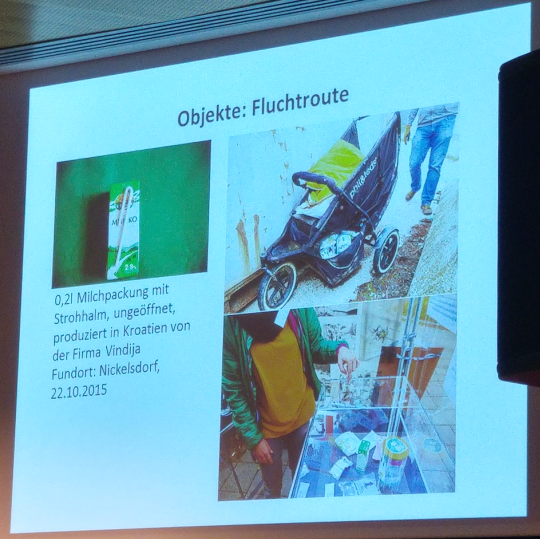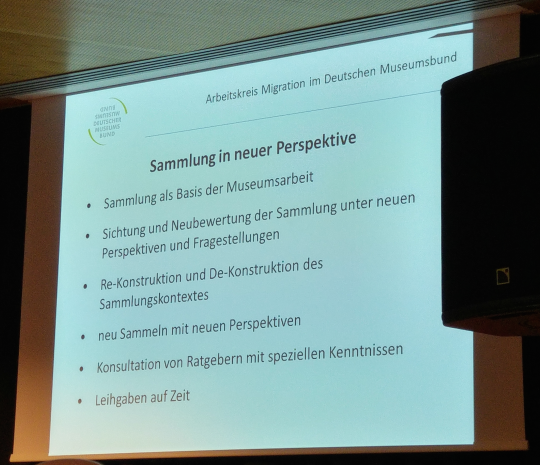#museumsworkersspeak
This year’s Austrian Museumstagwas held 6th-7th October in Eisenstadt with the theme of “Migration- Inclusion – Interaction” and included a mix of presentations, mostly focusing on the projects that have already been carried out in museums throughout Austria.
Migration has been a subject that has become more and more accepted within museum narratives over time, moving from the fringes and temporary exhibitions, to becoming an element that is both expected and demanded.
The development in Austria has been a bit slower than in other countries; Austria on the whole still does not consider itself to be a migration society, despite the sweeping and diverse histories of multi-ethnic Empire, in and out flows of refugees, economic and forced migrants. in a country at the heart of Europe with borders to eight other countries.
Project Presentations
There were two main streams to the projects presented as part of the two-day conferences:
- Projects that deal with historical migration and developing new collections that address ignored or missing element in the museum
- Projects that have been developed over the past two years in response to the growing number of people seeking asylum in Europe and Austria.
A couple of projects stood out: On day one, the presentation by Kazuo KandutschandChristiane Rainer was a highlight. Their project, as part of the organisation Geschichte Willkommen(History Welcome) , initiated a short rapid-response collection of objects relating to the months when the migration “crisis” was at its peak in 2015 (Sept-Nov). They covered some of the ethical considerations and decisions that had to be made at short notice, such as choosing not to speak to people (“How can you ask people who have nothing to donate something?”) and instead adopting a ‘rubbish archaeology’ approach, selecting objects left behind at the various camps and border crossings, photographing them in context, but unable to collect information about the people who collected them. They also described some of the topics and objects they were collecting, including donations from members of the Austrian public (including some of the more surreal things, such as ornaments and evening dresses), the routes taken (for example, a 20ml carton of milk from Croatia that was left in Austria - see picture below) and the bureaucracy that went along with it (e.g. pictograms from the emergency accommodation showing how to use European-style toilets). The project was self-critical, showing an awareness of how such projects can be problematic, but also why their approach was chosen as the most appropriate.

From the presentation about Geschichte Willkommen
Another stand out project was Migration Sammelna collection campaign commissioned by the Vienna City Government as a response to a campaign to develop a Migration Archive. The project was carried out by an external project team (represented by Vida BakondyandRegina Wonisch, with the intention of the objects becoming part of the Vienna City History Museum’s (Wien Museum) collection. The presentation was honest about some of the structural problems that come with short-lived projects that seek to fill an identified gap, namely, that the relationships that have to be developed in order to collect the stories and develop trust that might lead to people donating their objects to the museum are then abruptly ended when the project is, and the fact that the people contracted in this case acted as a sort of ‘buffer’ between the museum and the people; the objects become part of the collection, but the connections and relationships that were built cannot be maintained.
Overall, there was level of agreement that instead of trying to bend the subject of migration to the current methods of collecting and representation, that museums, curators, educators – indeed every aspect of the institution – instead need to think about how migration and the new and expanded perspectives and approaches of the museum might need to change and adapt.
Employment Practices
One aspect that was mentioned in passing a couple of times – but wasn’t subject to a thorough discussion in its own right - was the question of how well the museum field really reflects the communities they serve? It’s something that this blog has looked at in the past (see “#Museumworkersspeak” and “Immaculate Integration”), but the problem again is one that might be addressed by not expecting migrants or “people with a migration background” (a term often used in Austria is a fuzzy term that can mean anything from 1st generation migrants to those who have one or two parents born abroad) to conform to the same old employment requirements. The question has to be asked: How long will museums continue to require the same things but hope to attract a different profile of people? Again, there needs to be a re-evaluate the kind of institution you are. If what you have isn’t what you are aiming for, perhaps you need to rethink the structures and processes in place and how they might perpetuate the problems and inequalities you are trying to overcome.

From the presentation by Dietmar Osses about the guidelines produced by the German Museums Association, here on collection practices.
The conference was organised by the Museumsbund Österreich,ICOM Österreich and the Landesmuseum Burgenland.
Post link

